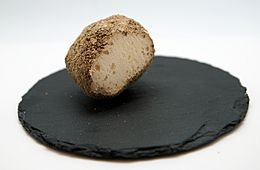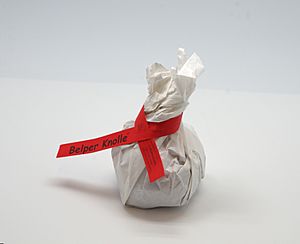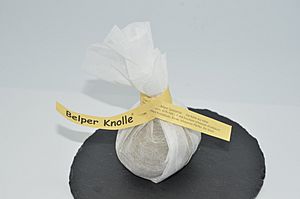Belper Knolle facts for kids
Quick facts for kids Belper Knolle |
|
|---|---|
 |
|
| Country of origin | Switzerland |
| Region, town | Belp, Canton of Bern |
| Source of milk | Simmental Cows |
| Pasteurized | No |
| Texture | hard (gold) or soft (red) |
| Aging time | min. 3 months |
| Named after | Lua error in Module:Wikidata at line 70: attempt to index field 'wikibase' (a nil value). |
The Belper Knolle is a very special Swiss cheese. Its name means "Belp Ball" in German. This unique cheese comes from the small town of Belp in Switzerland. It is famous for its interesting shape, which looks a bit like a truffle.
Contents
What is Belper Knolle Cheese?
Belper Knolle is a type of cheese made from cow's milk. The milk comes from Simmental cows. What makes it special is that the milk is unpasteurized. This means it has not been heated to kill germs. Using unpasteurized milk gives the cheese a very rich and unique flavor.
Where Does Belper Knolle Come From?
This cheese is made only in the town of Belp. Belp is located in the Canton of Bern in Switzerland. The cheesemakers there follow traditional methods. This helps keep the cheese's special taste and quality.
How is Belper Knolle Made?
Belper Knolle starts with fresh, unpasteurized cow's milk. After the cheese is formed, it is aged for at least three months. This aging process helps the cheese develop its flavor and texture.
Fresh vs. Dry: The Two Types
Belper Knolle comes in two main types. They are called red and gold. The difference depends on how long the cheese has been aged.
- Red Belper Knolle is the fresh version. It is softer and has a milder taste.
- Gold Belper Knolle is the dry version. It has been aged longer. This makes it much harder and gives it a stronger, more intense flavor.
How to Enjoy Belper Knolle
You can enjoy Belper Knolle in different ways. The fresh, red version can be softened. Some people heat it gently to about 60 degrees Celsius. Then they might serve it in a special stone dish. The dry, gold version is often grated. It can add a burst of flavor to many dishes. People use it like a spice or a topping.



